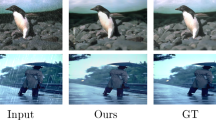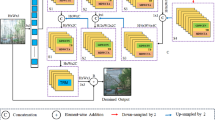Abstract
Deraining is an essential preprocess for many computer vision tasks, e.g., vision-based autonomous driving. The existing methods usually depend on the prior information or specified network structures and correspondingly suffer from high computational costs. To enhance the performance to meet the real-time requirement of autonomous driving, we propose a novel end-to-end recurrent multi-level residual learning deraining network featured with the global attention mechanism and residual network architecture. In the proposed Recurrent Multi-level Residual and Global Attention Network (RMRGN in short), we employ a recurrent stage scheme to gradually utilize global contextual information and image details to remove the rain streaks progressively. The global-attention mechanism enables us to focus on the meaningful context in every recurrent stage, which further benefits the network to distinguish the rain streaks and the rain-free images. By exploring the attention information, we further propose a deep multi-level residual learning network to eliminate rain streaks in a single image. Comprehensive experimental results demonstrate that RMRGN performs favorably against the state-of-the-art methods for removing rain streaks.












Similar content being viewed by others
References
Cao Y, Xu J, Lin S, Wei F, Hu H (2019) Gcnet: Non-local networks meet squeeze-excitation networks and beyond. In: Proceedings of the IEEE/CVF International Conference on Computer Vision Workshops, pp 00,
Chen YL, Hsu CT (2013) A generalized low-rank appearance model for spatio-temporally correlated rain streaks. In: Proceedings of the IEEE international conference on computer vision, pp 1968–1975
Collins Robert T, Lipton Alan J, Takeo K, Hironobu F, David D, Yanghai T, David T, Nobuyoshi E, Osamu H, Peter B et al (2000) A system for video surveillance and monitoring. VSAM Final Rep 1(2000):1–68
Eigen D, Krishnan D, Fergus R (2013) Restoring an image taken through a window covered with dirt or rain. In: Proceedings of the IEEE international conference on computer vision, pp 633–640
Fan Z, Wu H, Fu X , Hunag Y, Ding X (2018) Residual-guide feature fusion network for single image deraining. arXiv preprint arXiv: 1804.07493
Farenzena M , Bazzani L , Perina A , Murino V , Cristani M (2010) Person re-identification by symmetry-driven accumulation of local features. In: 2010 IEEE computer society conference on computer vision and pattern recognition, pp 2360–2367. IEEE
Fu X, Huang J, Ding X, Liao Y, Paisley J (2017) Clearing the skies: a deep network architecture for single-image rain removal. IEEE Trans Image Process 26(6):2944–2956
Fu X, Huang J, Zeng D, Huang Y, Ding X, Paisley J (2017) Removing rain from single images via a deep detail network. In: Proceedings of the IEEE conference on computer vision and pattern recognition, pp 3855–3863
Fu X, Liang B, Huang Y, Ding X, Paisley J (2019) Lightweight pyramid networks for image deraining. IEEE Trans Neural Netw Learn Syst 31(6):1794–1807
Han P, Liu G, Huang S, Yuan W, Lu Z (2016) Segmentation with selectively propagated constraints. In: International conference on neural information processing, pp 585–592. Springer
Han P, Shang S, Sun A, Zhao P, Zheng K, Zhang X (2021) Point-of-interest recommendation with global and local context. IEEE Trans Knowl Data Eng
He K, Sun J, Tang X (2012) Guided image filtering. IEEE Trans Pattern Anal Mach Intell 35(6):1397–1409
He K, Zhang X, Ren S, Sun J (2016) Deep residual learning for image recognition. In: Proceedings of the IEEE conference on computer vision and pattern recognition, pp 770–778
Hu H, Gu J, Zhang Z, Dai J, Wei Y (2018) Relation networks for object detection. In: Proceedings of the IEEE conference on computer vision and pattern recognition, pp 3588–3597
Huynh-Thu Q, Ghanbari M (2008) Scope of validity of PSNR in image/video quality assessment. Electron Lett 44(13):800–801
Itti L, Koch C, Niebur E (1998) A model of saliency-based visual attention for rapid scene analysis. IEEE Trans Pattern Anal Mach Intell 20(11):1254–1259
Kang LW, Lin CW, Fu YH (2011) Automatic single-image-based rain streaks removal via image decomposition. IEEE Trans Image Process 21(4):1742–1755
Kingma DP, Ba J (2014) A method for stochastic optimization. arXiv:1412.6980
Li X, Wu J, Lin Z, Liu H, Zha H (2018) Recurrent squeeze-and-excitation context aggregation net for single image deraining. In: Proceedings of the European Conference on Computer Vision (ECCV)
Li Y, Tan RT, Guo X, Lu J, Brown MS (2016) Rain streak removal using layer priors. In: Proceedings of the IEEE conference on computer vision and pattern recognition, pp 2736–2744
Lin H, Li Y, Fu X, Ding X, Huang Y, Paisley J (2020) Rain o’er me: Synthesizing real rain to derain with data distillation. IEEE Trans Image Process 29:7668–7680
Luo Y, Xu Y, Ji H (2015) Removing rain from a single image via discriminative sparse coding. In: Proceedings of the IEEE International Conference on Computer Vision, pp 3397–3405
Maji S, Berg AC, Malik J (2008) Classification using intersection kernel support vector machines is efficient. In: 2008 IEEE conference on computer vision and pattern recognition, pp 1–8. IEEE
Mandic D, Chambers J (2001) Recurrent neural networks for prediction: learning algorithms, architectures and stability. Wiley, New York
Mirza M, Osindero S (2014) Conditional generative adversarial nets. arXiv:1411.1784
Nair V, Hinton GE (2010) Rectified linear units improve restricted boltzmann machines. In: Icml
Niu Y, Lu Z, Huang S, Han P, Wen JR (2015) Weakly supervised matrix factorization for noisily tagged image parsing. In: IJCAI
Paszke A, Gross S, Chintala S, Chanan G, Yang E, DeVito Z, Lin Z, Desmaison A, Antiga L, Lerer A, Automatic differentiation in pytorch, Alban Desmaison
Ren D, Zuo W, Hu Q, Zhu P, Meng D (2019) Progressive image deraining networks: A better and simpler baseline. In: Proceedings of the IEEE/CVF Conference on Computer Vision and Pattern Recognition, pp 3937–3946
Simonyan K, Zisserman A (2014) Very deep convolutional networks for large-scale image recognition. arXiv preprint arXiv: 1409.1556
Sun H, Ang MH, Rus D (2019) A convolutional network for joint deraining and dehazing from a single image for autonomous driving in rain. In: 2019 IEEE/RSJ International Conference on Intelligent Robots and Systems (IROS), pp 962–969. IEEE
Szegedy C, Liu W, Jia Y, Sermanet P, Reed S, Anguelov D, Erhan D, Vanhoucke V, Rabinovich A (2015) Going deeper with convolutions. In: Proceedings of the IEEE conference on computer vision and pattern recognition, pp 1–9
Tomasi C, Manduchi R (1998) Bilateral filtering for gray and color images. In: Sixth international conference on computer vision (IEEE Cat. No. 98CH36271), pp 839–846. IEEE
Wang X, Girshick R, Gupta A, Kaiming H (2018) Non-local neural networks. In: Proceedings of the IEEE conference on computer vision and pattern recognition, pp 7794–7803
Wang Z, Bovik AC, Sheikh HR, Simoncelli EP (2004) Image quality assessment: from error visibility to structural similarity. IEEE Trans Image Process 13(4):600–612
Wei W, Meng D, Zhao Q, Xu Z, Wu Y (2019) Semi-supervised transfer learning for image rain removal. In: Proceedings of the IEEE/CVF conference on computer vision and pattern recognition, pp 3877–3886
Xingjian SH, Chen Z, Wang H, Yeung DY, Wong WK, Woo WC (2015) Convolutional lstm network: A machine learning approach for precipitation nowcasting. In: Advances in neural information processing systems, pp 802–810
Yang W, Tan RT, Feng J, Liu J, Guo Z, Yan S (2017) Deep joint rain detection and removal from a single image. In: Proceedings of the IEEE conference on computer vision and pattern recognition, pp 1357–1366
Yu F, Koltun V (2015) Multi-scale context aggregation by dilated convolutions. arXiv: 1511.07122
Zhang H, Dana K, Shi J, Zhang Z, Wang X, Tyagi A (2018) Context encoding for semantic segmentation. In: Proceedings of the IEEE conference on Computer Vision and Pattern Recognition, pp 7151–7160
Zhang H, Sindagi V, Patel VM (2019) Image de-raining using a conditional generative adversarial network. IEEE Trans Circuits Syst Video Technol 30(11):3943–3956
Zhu L, Fu CW, Lischinski D, Heng PA (2017) Joint bi-layer optimization for single-image rain streak removal. In: Proceedings of the IEEE international conference on computer vision, pp 2526–2534
Author information
Authors and Affiliations
Corresponding author
Ethics declarations
Conflict of interest
The authors declare that they have no conflict of interest.
Additional information
Publisher's Note
Springer Nature remains neutral with regard to jurisdictional claims in published maps and institutional affiliations.
Rights and permissions
About this article
Cite this article
Wang, M., Li, C. & Ke, F. Recurrent multi-level residual and global attention network for single image deraining. Neural Comput & Applic 35, 3697–3708 (2023). https://doi.org/10.1007/s00521-021-06814-w
Received:
Accepted:
Published:
Issue Date:
DOI: https://doi.org/10.1007/s00521-021-06814-w




